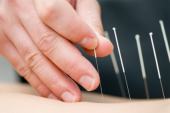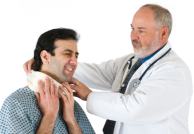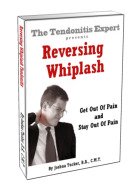Treatment For Whiplash
There is a whole spectrum of different kinds of Treatment for Whiplash (and the Neck Tendonitis that comes with it) out there.
Some options are effective.
Some of them are a waste of time and money.
Having said that, some things that I would label a 'waste' of time and money have totally healed some people.
My reviews of the following Whiplash Neck Injury Treatment -OPTIONS- are all from my education and professional experience as a medical massage therapist as well as personal use and experience.
Feb 1st or sooner!

If you haven't read the following two pages yet, you may want to. I'm going to refer to them a good amount so I'm going to put the links here once and not down the rest of the page.
Inflammation and The Pain Causing Dynamic.
Treatment For Whiplash -- Options
In no particular order:
* Treatment for Whiplash - Acupuncture for Whiplash:
I give acupuncture for whiplash a thumbs up.
It calms the nervous system, can reduce the 'fear' the nervous system is holding around the accident/injury, and rebalances the body's energy system.

It can be effective at reducing Inflammation and the Pain Causing Dynamic.
It makes sense that the accident's jolt to the body can knock your energy off it's usual energetic pathways. Acupuncture can realign you, on several different levels. I've actually had this experience and felt my body pull for realignment.
Pretty wacky, but I respect that it works whether you believe in it or not.
* Treatment for Whiplash - Immobilization with a Cervical Collar
Immobilization is only good if you have a severe, drastic, 10 out of 10 injury. Sometimes you need to be held still because the damage and the dynamic is so acute, any movement at all is too much for your system to handle.
Still, have you ever noticed with any kind of injury, that when you are moving you're pretty ok, but as soon as you stop for a while things tighten up, get more stiff, and hurt more?
The nervous system clamps down around injury.
Movement is actually better. Even little, tiny movement as often as you can is better than staying still. It keeps things 'warmed up' and getting new circulation in and out.
I know it's hard to do that when you are in pain, but you will get out of pain faster if you keep things moving as much as you can.

Most of the real pain is from Inflammation and the chemicals it releases that enhance your sensation of pain. A collar isn't going to combat that.
A cervical collar can actually increase Inflammation and the Pain Causing Dynamic.
Even if it hurts some, you want (a little bit of) movement more than not.
I'll make a youtube video and link it here in the near future, showing you exactly how to 'keep moving'.
* Treatment for Whiplash - Cervical Traction
Traction is not a bad option. I don't think it's a great one, but it's not a bad one.
Do not do traction when you are in acute pain.
Then, in general, a little bit of traction can be beneficial.
It puts a little bit of length and stretch to all the structures holding your vertebrae together.
If you do gentle traction, the nervous system will relax and let all those structures lengthen, will let the musculature relax.
This could be indirectly effective at reducing Inflammation and the Pain Causing Dynamic, depending.
If you put too much traction on, the nervous system will fear more damage and clamp down, so you have to be very aware.
Also, it's hard to exactly target traction and/or exert even pressure/pull down the spine.
Some chiropractors have a machine called a DRX-9000, or a less expensive machine called the Triton.
I have heard some great things about these machines. A bit pricey and at this point not covered by insurance, but they may be worth the money if you have it to experiment with.
They measure, modulate, and change the traction and are fairly accurate about how and where they exert the traction.
They are designed for bulging/ruptured discs in the neck and spine (which you can get in a severe whiplash causing accident).
* Treatment for Whiplash --Anti-Inflammatory medicine:
NSAIDs are Non Steroidal Anti Inflammatory Drugs.
Over the counter anti-inflammatories are not a bad option in the short run.
Inflammation has it's upsides and it's downsides. Knocking it down with an anti-inflammatory is a good idea.
If you don't feel it working after a couple times, stop using this method, as it comes with its own dangers.
Ice is a way better option in my opinion anyway.
* Treatment for Whiplash -- Chiropractic
I give a thumbs down to 'forced adjustment' chiropractic care for whiplash injury, especially in the acute stage and in the week(s) after the acute stage
Chiropractic is as good as it usually is for later stage and chronic whiplash. It's good to keep inner structures moving, but limited in it's ability to create permanent change.
The last thing my nervous system wants when my neck is injured is somebody quickly jerking on it. Maybe yours doesn't, but my nervous system doesn't like the idea of fast movement and potential pain at all. Not at all.
In theory its good. It may work for you.
But the nervous system is keeping your neck tight and guarded for a reason, and it doesn't understand that the good dr.'s intentions. It just knows that you are injured, that it is protecting you by tightening up, and that some guy is putting his hands around your head and neck and is about to twist your really fast and really hard.
The nervous system will tighten up even more. And if the adjustment causes actual pain, it will tighten up EVEN MORE.
More gentle forms of chiropractic I give a thumbs up to.
Again, you want an extremely skilled chiropractor working on you.

* Treatment for Whiplash --
Corticosteroid Injections: I wouldn't.
There is considerable risk. There is questionable value.
Corticosteroid injections are generally reliable to reduce pain, but temporarily.
They neither heal nor positively effect the physical damage in your neck, nor the Pain Causing Dynamic.
* Treatment for Whiplash -- Cervical Microdiscectomy, Cervical Discectomy,
This surgery cuts through your skin, several layers of connective tissue, and almost certainly the bone of your vertebrae.
This surgery is ONLY for extreme cases of whiplash injury where you also get damage to the vertebral disc.
If your disc exploded from the force of the impact and is pushing on your spinal nerve, surgery is probably a good idea to get that material off there.

If you don't have severe numbness or paralyzed limbs, you probably don't need the surgery.
Statistically, people with bulging discs and minor numbness that get the surgery and don't get the surgery end up in almost exactly the same state of health 12 months later....totally or mostly pain free.
Surgery itself increases Inflammation and the Pain Causing Dynamic. Plus you have to heal from the damage the actual surgery causes.
It's really a treatment for a damaged spinal disc, not a treatment for whiplash.
It can't help Tendonitis of the Neck, or is it beneficial for 'normal' whiplash'.
* Treatment for Whiplash -- Rest
Resting a Whiplash Injury isn't really a treatment option. It is a fall back strategy.
"Time Heals All" is only true in a general sense.
In my experience people only stop and rest their neck when it hurts to bad to do anything else.
And moderate to severe whiplash can leave you feeling like that.
Rest mostly stops more irritation, but it does not decrease pain directly, and increased rest will not result in increased healing.
There is a difference between Rest and Relaxation. Move your neck as much as you can within pain tolerance. (See Neck Wiggles below)
Don't make it hurt more, but keep it moving. This is much more effective than rest.
* Treatment for Whiplash -- Heat
NO! No no no.
Heat packs, wet heat, standing under a hot shower.
Feels good, but NO!
Assuming that you have read the Inflammation page, you know that Inflammation traps fluid in the area.
Heat increases Inflammation.
Heat feels good temporarily because it brings new blood and nutrition to the area.....which means that new fluid is going to get trapped there. That's a problem and it actually prolongs your suffering and can actually make your pain and injury dynamic worse.
Heat is great for minor aches and pains. Whiplash is not a minor ache or pain.
Don't use Heat by itself. After the acute phase of your injury is over (the first 72ish hours), alternate heat with Ice Therapy. ALWAYS finish on cold.
* Treatment for Whiplash -- Ice Therapy
Ice is your best friend. Really.
It is one of the top, most effective methods for the treatment for whiplash, tendonitis, and related pain because it directly decreases Inflammation.
Imagine squeezing a wet sponge. When you squeeze, old stuff gets squished out, and when you let go, new fluid gets pulled in.
Cold makes small muscle tissue contract. So when you put cold on your skin/flesh/body, its like the sponge squeezes itself.
Old stuff out, new stuff in.
Meaning, waste product and pain enhancing chemical out, new blood and nutrition in.
Alternate with Heat, and you get an even bigger circulatory turnover. Circulation is GOOD when you have a whiplash type or a tendonitis type injury.
Then ice pack, cold pack, plastic bag full of ice cubes, frozen pack of corn (not peas...peas start to stink like, well, peas, when they are half thawed). You want something cold, big, and heavy.
You want it big to cover as much area as possible and heavy to 'push' the cold deeper into your structures.
Don't apply something frozen directly to your skin, you can give yourself frostbite if you aren't careful. It's generally not a problem, but.....
Ice for 15-20 minutes, no more. Then remove the cold for 15-20 minutes. Then apply the cold again.
Repeat this over and over, as much as you can.
The more you ice, the faster your pain will go away
I can't overstate that enough. You want the cumulative effect of icing over and over. The more the merrier.
Let me say it again. The more you ice, the faster your pain will go away.
Ice is your friend. It's the best treatment for whiplash pain.
* Treatment for Whiplash -- Pain Killers
See the
Anti-Inflammatory page. Basically, these are -OK- in the short term treatment for whiplash, but only to temporarily ease your suffering.
Pain serves a function, and it may be a good idea not to hide it from your system with Pain Killers.
Here is a generalization. People that rely on pain killers to dull the pain 'until it heals' have more pain and suffer longer than people that don't.
This is a function of people having less pain when they use effective methods to -heal the injury- quickly as opposed to using painkillers and hoping for the best.
Which, by the way, is a very ineffective method of treatment for whiplash.
* Treatment for Whiplash -- Muscle Relaxers
If these work for you, great.
They don't do anything for me, so I personally wouldn't use them for Tendonitis -or- for treatment of whiplash.
If they can actually override your nervous system and help muscles relax this allows more circulation and possibly more nervous system ease.
Use pain killers as a very short term tool and make sure you use Ice and Movement along with.
If they don't do anything for you, I suggest you not use them. Your body doesn't need to deal with the contents of those pills if there is no beneficial trade off.
* Treatment for Whiplash -- Restful Sleep
Getting restful sleep is vital for healing from a wound or an injury.
There is a point in your sleep cycle where you physiologically regenerate, or heal. This only happens if you get restful sleep.
The problem with Tendonitis in the Neck and Whiplash is that pain and discomfort generally keep you from getting restful sleep.
Sleeping pills fail to provide restful sleep for people in pain. The pills knock a person out but somehow don't allow the body to sleep in such a way that you get into that regenerative state.
Sleeping pills -may- work for you. If you take them and wake up feeling refreshed and well rested, that's great. If you try sleeping pills and wake up feeling tired and haggard, it may be best not to drug your body. It's got enough to deal with with your whiplash injury.
I have found that one of the best ways to get better sleep, even restful sleep, is to use and icepack on the painful parts of the neck before, and as you go to sleep.
Make sure you use a coldpack that will warm up eventually so it's not frozen on you for more than 15-20 minutes. That way you can safely fall asleep with it.
Something about icing as you fall asleep helps you sleep better.
I don't know exactly what it is, but it does. Try it and see for yourself.
The Best, Most Effective Options
For The Treatment Of Whiplash
At Home Self Care for Whiplash and Neck Tendonitis
The Bad News is, it takes some time and effort.
The Good News, it works. And there are no dangerous side effects.
If you want to get out of pain and heal correctly, the following is the way to do it, in two parts.
First there is what you do at home.
The second is the professional help you find in the area you live, assuming that it is available.
If you don't do the Self Care treatment for whiplash at home, you vastly decrease the chances that you will end up pain free anytime in the near future.
If you want to deal with pain for months and decades, that's your call.
This self care routine is not for everyone. It takes some effort, some attention, and most importantly, it takes a resolve and a desire to 'defeat' your injury and your body's response to it.
Most people would rather take the quick and easy way with pain killers, muscle relaxants, and anti-inflammatory meds.
Unfortunately, those methods of treatment for whiplash don't work.
Most of my work the last decade was working with individuals that had tried many and various methods but still had pain.
Treatment For Whiplash
Self Care
1. Ice
Do as I said above in the Ice category above.
A heavy cold pack of some kind. 15 minutes on, 15 minutes off. Repeat as often as you can.
Do this a minimum of 10 times a day for moderate to severe pain.
If you do the math, that's a lot of time paying attention to icing.
Yes it is.
You can put the time in on the front end to effectively alter the Pain Causing Dynamic and decrease your pain, or you can suffer with whiplash pain for weeks, months, and then off and on for decades.
2. Neck Wiggles
This is a great healing activity, with the added bonus that if you have little kids, they will do it along with you and you can make a game out of it.
A Neck Wiggle is exactly what it sounds like.
Imagine a little kid laughing and wiggling her neck. It's a lot like that, only slower. (The laughter is optional.)
You want all your vertebrae to move, your head to move on top of the spine. In all different directions.
It looks a bit as if you had Parkinson's disease, that shake of the head and neck, but add in some rotation from side to side.
All angles, all directions.
This is neither stretching nor exercise.
You can do this during and after the acute phase, before, in between and after icing. As much as you can. Keep it moving. Every moment that you can remember to do it, do it.
Keep it moving.
The Rules of Neck Wiggle
Rule #1. Be very controlled at first with it, especially if you are in the acute phase and/or are in severe pain.
Rule #2. Keep your movements small and painless. If even small movements hurt, make them tiny movements.
Rule #3. Move in all directions, in any way that works for you.
Rule #4. As you do it, remember that every little movement is resulting in something beneficial happening inside your neck. (This is not positive thinking. This is just a true cause and effect dynamic.)
The Rules of Neck Wiggles Explained
Rule #1.
You want to keep you movements controlled until it becomes natural.
When you are in pain from whiplash, your nervous system is tightens up all your cervical muscles, protecting and guarding and, in effect, making all your muscles lock up.
This is a bad thing because tightness traps waste product in and keeps new blood flow and nutrition away from your neck structure.
If you wiggle/move your muscles too far or too fast, you will feel pain and trigger your nervous system to clamp down even harder.
Rule #2.
Keep your movements inside your easy range, your pain free range. Even tight muscles will give you some free range of movement, even if it is very small. You want to wiggle around inside that free, painless range of movement.
This will be a new experience for you. Pay attention, listen to your body, and find the right movement.
You will likely feel some discomfort, depending on your injury. You will know whether you need to make your movements smaller or not.
Rule #3 and Rule #4
You basically have muscle going in all directions in your neck. So if you move your neck in little movements in all directions, you will be lengthening and shortening all your muscles.
This keeps your neck from freezing up, locking up. You know how when you sprain your ankle, and you're fine till you stop walking, at which point it starts to hurt more, until you walk on it some more and get it 'warmed up'?
Same thing with your neck.
Neck Wiggles keep your neck warmed up, keeping it from freezing and locking up. Which is beneficial because it increases circulation and sends a lot of information to the nervous system.
If you stay within the pain free movement range, you will constantly be sending your nervous system pain-free messages. That will help LOTS.
It will help lots, If you do Neck Wiggles as much as you can so you get the cumulative effect of Neck Wiggling.
Ice as much as you can and do Neck Wiggles constantly.
Depending on your pain, it might take a day, possibly two to notice the effects.
Don't wonder whether it is working or not that first day or two.
It is working!
If it takes a day or two to notice benefit, that's because it has a lot of change to make UNTIL you are able to notice a decrease in symptoms.
Remember, this may occur as work and as a pain in the A#s, but it is temporary.
Whiplash can be permanent if you don't do anything effective for it.
Take your pick.
Also note that if you have had whiplash for a long time, and still have (occasional) symptoms, use this treatment for whiplash to get out of pain.
Home Treatment For Whiplash
Professional Whiplash Care
Use the Home Self Care to get out of pain. It may be all you need.
But if you have access to the right professional, -and- you do the Home Self Care, you can not only get out of pain, but you can heal 'correctly' and not have to deal with this accident ever again.
My recommendation is to find a highly skilled, highly experienced Massage Therapist.
When I compare education content and a profession's chosen treatment for whipash methodology and philosophy, I find that Massage Therapy has the best tools for and mindset for the SUCCESSFUL treatment for whiplash.
Granted, this requires a massage professional with the appropriate level of training and education and experience. As with every kind of professional, they are not all created equal.
There may or may not be one where you live, even if there are lots of massage therapists around.
Skilled Massage Therapy can:
* Work with the actual site of rip and tear where scar tissue is forming, to help you heal correctly, as opposed to the way your body heals whiplash and tendonitis injury, which is not as structurally strong as it was before.
* Get you out of pain faster
* Effectively deal with the rest of you body's reaction to the injury, and to compensating for the injury
How do you find a Skilled Massage Therapist?:
* Make sure they have a MINIMUM of 500 hours of schooling. (1,000 hours, really)
* Make sure they have experience successfully treating whiplash.
If you get a Treatment Massage and it's gentle, flowy, or superficial, find another therapist.
You want to feel that they know what they are doing when they touch you and talk to you.
You want to feel their fingers gently getting deep into your neck and finding the hot spots which are specific injury sites on your ligaments and tendons.
It may take some trial and error to find an extremely skilled Massage Therapist.
Some states and cities are better than others. Washington has a state license and a very high skill level of massage therapists, whereas California doesn't have a state wide licensure, it's all by city and county. Thus San Francisco requires only 120 hours of schooling to call oneself a 'Massage Therapist'.
120 hours of schooling is a pre-school level of education in the Massage Therapy field. Imagine if your surgeon only had 120 hours of schooling.
No one can provide effective treatment for whiplash with a preschool education.
Make sure you find someone that can make a difference for you.
Treatment For Whiplash
Complete Self Care Plan
I am a big believer in self care at home.
In my experience, you can do more for yourself in the long term (and the short term too) at home.
Granted, you need to know what you are doing.
There are lots of options out there. Creams and gels and massagers and such that you can buy online.
There are various self-care options out there.
Granted I'm biased, but I think the program I have put together (see below) will do you the most good if you follow the plan.
First and foremost, do the Home Self Care. If you can find a good Massage Therapist to provide skilled treatment for whiplash, even better. If you can't find one, rely on the Home Self Care. It will do you good.
**WARNING** DO NOT rely on your massage therapist, or any other health professional, to do it all for you. They can't. (Don't get me wrong, a skilled MT can help A LOT.)
The basis for healing from whiplash is actually doing the Home Self Care. Most injury requires a little bit repetitive work daily for best results.
Any 'professional' treatment for whiplash is doomed to fail, or at the very least take much much longer, if you don't.
Do the Home Self Care if you want to become pain free!
Also, a supportive treatment for whiplash is to give yourself all the protein and connective tissue nutritional support that you can get.
The best connective tissue healer and strengthener is Essential Bone Broth
If you want a Treatment for Whiplash, shop smart. There are plenty of them out there. Some are more effective than others, so the better you understand how Whiplash works, the better you'll be able to find a treatment for your whiplash that works.
Return to the top of this Treatment For Whiplash page.
Go to the main Whiplash Neck Injury page.
Go to the main Tendonitis page.
Go to the TendonitisExpert.com homepage.




